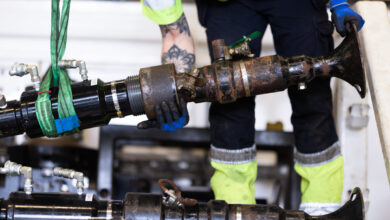Next-gen microchip plots cracks, pores through frac fluids

Rice University’s Integrated Systems and Circuits (RISC) laboratory has developed a new generation of microchips, approximately the size of a grain of sand, that travels downhole through fracturing fluids to plot the cracks and pores through which oil and gas move to the surface. Activated by electromagnetic signals sent from an aboveground transceiver, the microchips return real-time data to create high-resolution maps of reservoirs and formations formed by hydraulic fracturing.
The ongoing miniaturization of microchips, combined with their declining design costs and improved performance, aims to make an impact on the oil and gas industry. Data obtained from the chips can be used to decrease oil extraction costs in an era where low oil prices call for greater technology efficiency and innovation. For example, the RISC laboratory developed a prototype spectrometer – a device used to analyze chemicals – that for the first time uses microchips to locate and measure asphaltenes, deposits that clog production pipe. The lab greatly reduced costs from a $500,000 cabinet-sized machine traditionally used for the process to a $100 microchip that can be sent downhole to do the same.
RISC’s microchip research is being funded through sponsored research grants, most recently a $1.9 million award to the laboratory by a major oil producer.
“What this technology now allows producers to do is create intelligent oil and gas fields without a large capital expenditure, which is crucial when oil prices are hovering at $30 a barrel,” explained Aydin Babakhani, Assistant Professor of Electrical and Computer Engineering and leader of the RISC laboratory. “The microchips map geologic formations in the same way doctors use medical imaging systems to map vessels in the body.”
The RISC laboratory has seen a surge of interest in devices to help producers analyze conditions thousands of feet below the surface, reflected in the nearly $5 million in sponsored research contracts the lab has signed in the past six months. Among them is a new $2.4 million grant from a major producer to develop a potentially life-saving technology, a miniature terahertz-based sensor that continuously monitors for leaks of highly toxic hydrogen sulfide.
“Oil and gas companies are beginning to think more about advanced microchips that use technologies being developed for the Internet of Things, a network of devices embedded with sensors and network connectivity that enable objects to collect and exchange data,” Mr Babakhani continued. “RISC’s Houston-based laboratory is strongly positioned to foster the continued development of these devices with its expertise in sensing and wireless communications, and close proximity to the heart of the oil and gas industry.”




